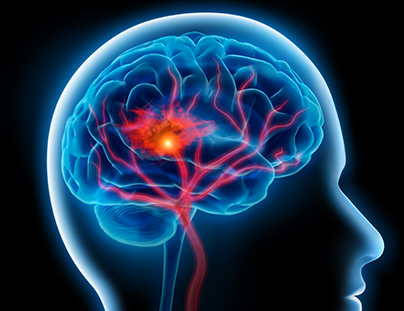A stroke is a form of cardiovascular disease (CVD) that occurs in the brain. There are two types of stroke: ischemic (or embolic) and hemorrhagic. With ischemic strokes, there is a disruption in blood flow to the brain tissue by cholesterol plaque, clot or arrhythmia resulting in tissue damage and death. With a hemorrhagic stroke, a blood vessel in the brain starts bleeding, decreasing blood flow to the part of the brain it supplies, as well as causing accumulation of blood. Transient ischemic attacks (TIA) or “mini-strokes” produce the neurological symptoms of a stroke which resolves within 24 hours and are a risk factor for future strokes.

Stroke has high morbidity and mortality rates and is a major cause of disability in the U.S. Stroke symptoms can improve with a Nutritarian diet, however, prevention of CVD with a Nutritarian diet offers the greatest benefit.
An estimated 6.8 million Americans over the age of 20 have had a stroke. Stroke prevalence will increase 20.5% by 2030. Approximately 795,000 people have a new or recurrent stroke each year. On average, every 40 seconds, someone in the U.S. experiences a stroke. It is the leading cause of disability in the U.S. The direct and indirect cost of stroke in 2010 was $36.5 billion and will continue to increase each year if the poor diet and sedentary lifestyles of Americans aren’t addressed.1
Symptoms of a stroke include facial droop, visual changes, slurred speech, dizziness, loss of balance or coordination, and weakness or paralysis of extremities. A TIA can involve any of these symptoms that resolve within 24 hours.
Learn more about how to identify a stroke by reading Stroke Information & Resource Guide from ACLS Training Center.
The main cause of an ischemic or embolic stroke is the Standard American Diet, which is low in vitamins, minerals, and antioxidants but high in inflammatory animal products and refined/processed foods. This leads to inflammation, oxidative stress, and immune dysfunction that promote vascular damage. Strokes are associated with diseases that are a result of poor diet such as high blood pressure, high cholesterol, diabetes, atrial fibrillation, and chronic kidney disease. Tobacco use and a sedentary lifestyle also contribute to stroke risk. Hemorrhagic strokes have a different constellation of risks, including salt, medications, and alcohol use and a low cholesterol level versus a high cholesterol level for ischemic stroke.
Tobacco use increases CVD risk by increasing oxidative stress leading to arterial lining damage and hardening of the vessels. Smokers have a two- to fourfold increased risk of stroke compared to lifelong nonsmokers or those who quit smoking more than 10 years prior.1
ONLINE: All members of DrFuhrman.com can search the Ask the Doctor archives for discussions on this topic. Platinum and Diamond members can connect with Dr. Fuhrman by posting questions in the forum. Not a member? Join now.
IN PERSON: Book a stay at Dr. Fuhrman’s Eat to Live Retreat in Southern California. With options ranging from one, two and three months (and sometimes longer) you will be under Dr. Fuhrman’s direct medical supervision as you hit the “reset” button on your health. For more information: (949) 432-6295 or [email protected].
EVENTS: Join Dr. Fuhrman for an online boot camp, detox or other event. During these immersive online events, you’ll attend zoom lectures, follow a special meal plan, and have access to a special, live Q&A session with Dr. Fuhrman. Learn more about events.
The following are sample questions from the Ask the Doctor Community Platinum and higher members can post their health questions directly to Dr. Fuhrman. (All members can browse questions and answers.)
If one has had a stroke (after atrial fibrillation) and is advised by the cardiologist to take blood-thinners the rest of their life, is there still the possibility, in your opinion and experience, to get rid of the blood-thinner?
Yes, if the person gets healthy with Nutritarian eating and gets rid of their stroke risk factors. That means they have to achieve a normal weight, blood pressure, and lipid profile without medications. At that point, the risk of the blood thinning agents can be greater than the supposed benefits.
Dr. Fuhrman has mentioned that those who follow a Nutritarian diet have to be particularly careful not to consume excess salt because we don’t have the "benefit" of atherosclerosis protecting us from that particular effect. What is the mechanism by which excess sodium causes bleeding strokes in people who don’t have atherosclerosis? Is high blood pressure always present? Is there a lowered risk when blood pressure is normal or low despite excess sodium?
Yes, there would be less risk with lower blood pressure, however, frequently, after years and years of salt intake, the sympathetic tone in the central nervous system flips and you suddenly have high blood pressure. Then, people say, "that’s strange, I always had low blood pressure my entire life and now suddenly it is running high all the time." Then, cutting back or cutting out the salt is too late. In other words, just because you have low blood pressure now, does not mean you have permission to use excess salt.
In fact, this is how most people operate. They are told by the media and health professionals they only have to watch salt intake if they have high blood pressure. Then, later in life when they develop high blood pressure, they cut back on salt, but the blood pressure does not come down from all those years of self-abuse. So, now you have a correlation between low salt intake and higher risk of cardiovascular disease from all those individuals that had a high salt intake in their past but are not using much salt once they developed serious cardiovascular pathologies.